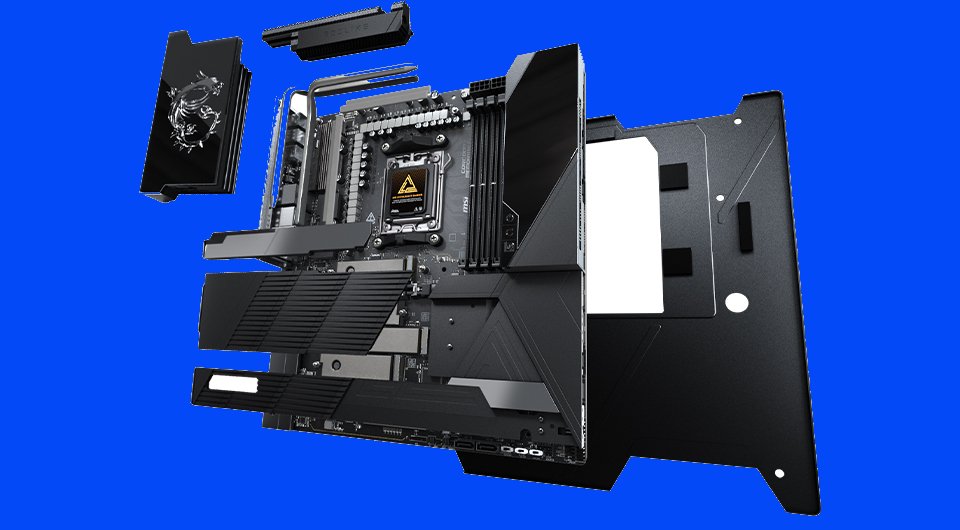MSI outs 'world's first' ATX 3.1-ready mobos with extra PCIe juice for power-crazed next-gen GPUs
Up to 420 W of motherboard power, and that's not even counting the CPU.

MSI has outed its new X870 and X870E motherboards for AMD AM5 processors, including the new Ryzen 9000-series chips. The big news is ATX 3.1 support and a big boost in PCIe power supply.
MSI says the boards' new supplemental PCIe Power feature delivers a major boost in overall board and GPU power supply. That could well come in handy, what with expectations of ever greater power draw from upcoming GPUs, particularly Nvidia graphics cards like the rumoured 550 W RTX 5090.
The power boost comes courtesy of an integrated 8-pin PCIe power connector on the motherboard itself. Conceptually, it's a little like the supplemental power connectors that already feed power to the CPU socket.
The PCIe Power feature pairs with support for the new ATX 3.1 standard to enable 2.5x "power excursion" for the PCIe graphics slot. In plain English, that ups power delivery from 66 W to a maximum of 165 W for the primary PEG-16 slot.
Of course, high-end GPUs suck down a lot more juice than that. The balance will come courtesy of the new ATX 3.1 12V-2x6 power connector for graphics cards, which is very similar to, and backwards compatible with the troubled 12VHPWR connector that led to all those melty RTX 4090 GPUs.
Anyway, upping the power supplied to the PCIe slot itself serves to increase overall power budget available to GPUs. But that's not all. The PCIe Power feature actually adds more power than just that PEG-16 slot increase.
Overall it contributes an additional 252W. That combines with the existing 168 W of board power delivered by the 12V rail in the main 24-pin ATX power connector to provide a grand total of 420 W. Note, that's 420 W just for the PCIe slots, RGB and fan headers and all that gubbins. It does not include the CPU, which has its own power circuit.
Keep up to date with the most important stories and the best deals, as picked by the PC Gamer team.
Indeed, the new MSI boards can deliver a slightly batty 132 W just to the fan headers. So, yeah, cooling shouldn't be a problem, no matter how crazy you go with your CPU and GPU specs. You will, of course, need one heck of a PSU to feed these boards, plus a high-end CPU and GPU.
If you've got a GPU drawing up to 600 W, an Intel CPU sucking 300 W or more, plus 420 W of motherboard power, well, you probably need a PSU rated at about 1,500 W to be on the safe side, which is getting pretty close to the peak wattage of a standard 15A US power socket, which comes in a 1,800 W.
That does rather beg the question of where all this escalating power draw might end. Likewise, as welcome as all these new power connectors are, the whole ATX standard does seem to have fallen miles behind the reality of modern PC components and their power requirements.

Best CPU for gaming: The top chips from Intel and AMD.
Best gaming motherboard: The right boards.
Best graphics card: Your perfect pixel-pusher awaits.
Best SSD for gaming: Get into the game ahead of the rest.
Surely the main 24-pin connector would benefit from an overhaul that would see it capable of handling all power requirements. Along with a major revision to the PCIe power standard, imagine just one power cable for everything rather than this proliferating rat's nest of extra cables and connectors. Surely this is not beyond the wit of man?
Instead, we now have supplementary motherboard connectors for GPUs as well as CPUs, but you'll still have to plug another cable into the graphics card itself. It's all a bit of a kludge.
MSI isn't absolutely explicit regarding which motherboards will get these new ATX 3.1 features. But we believe all X870 and X870E Series motherboards are included, and you can see the full lineup here. Either way, models with supplemental PCIe power will be available on September 26, so you can feed your massively multi-cable fetish in just over a week. Good luck!

Jeremy has been writing about technology and PCs since the 90nm Netburst era (Google it!) and enjoys nothing more than a serious dissertation on the finer points of monitor input lag and overshoot followed by a forensic examination of advanced lithography. Or maybe he just likes machines that go “ping!” He also has a thing for tennis and cars.

